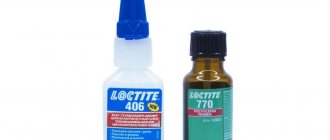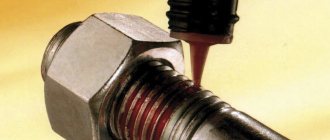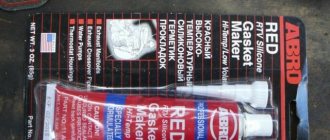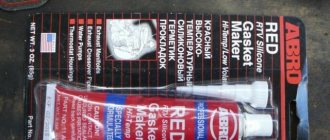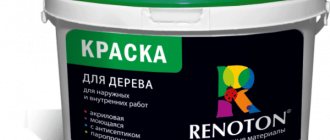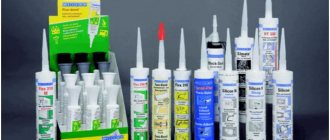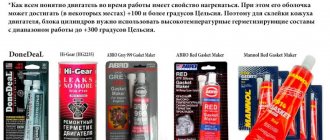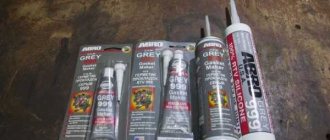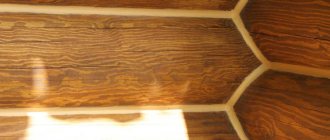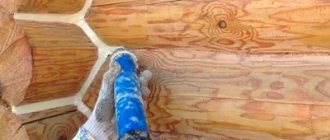Loctite threadlockers are anaerobic, one-component adhesives designed to provide permanent tightening and sealing of threaded connections and protect them from external corrosive influences. The adhesive fills the inter-threaded space and after installation turns into a solid polymer, providing reliable fixation. If dismantling is necessary, disassembly is carried out with hand tools.
The manufacturer Loctite is part of the reputable chemical-industrial concern Henkel Group, specializing in the production of industrial sealants and adhesives. German quality and environmental safety of products is confirmed by relevant certificates. A significant portion of threadlockers are NSF food grade approved.
A little about Loctite
The Loctite company is a global manufacturer of various adhesives, sealants and other materials. The company's history began in Harford, Connecticut, USA. In 1953, chemist Vernon Krieble succeeded in producing an ester polymerization inhibitor that cured in a vacuum. It was the world's first anaerobic glue.
In 1956, the scientist introduced a material that was designated as a “liquid locknut.” Kriebl guaranteed that this composition would completely solve the problem of self-unscrewing and insufficient fixation of threaded connections in various mechanisms. Somewhat later, the scientist, together with Pavel Haviland, founded the American Sealants company, which in 1963 was renamed Loctite Corporation.
The created company was engaged in its own development and production, and also acquired other companies, for example, Permatex in 1972, a manufacturer of various compounds for car maintenance and repair. Permatex has made Loctite the market leader in automotive specialty materials.
In the 60s of the 20th century, cyanoacrylate adhesives were developed, which became known as “Superglue”. These were one-component formulations for industrial applications that could polymerize at room temperature. Later, other types of materials appeared: silicone, acrylic, epoxy compounds, as well as new generations of anaerobic and cyanoacrytal adhesives.
In 1997, Henkel acquired Loctite, keeping the brand name unchanged. Today, this is one of the most successful divisions of the German concern, which has been producing high-quality adhesives and sealants that are in demand in many industries for more than 50 years.
Industrial sealants
They are used for elastic sealing to prevent the penetration of moisture inside or to eliminate the passage of air between assemblies, components and elements. Sealing is achieved through the adhesion of the sealant to surfaces, which can be made of the same or different structural materials. In addition, plastic sealants withstand the displacement of two elements relative to each other.
Plastic sealing prevents foreign particles from entering components and parts. Sealants for this type of seal, when exposed to external loads, change shape plastically, i.e. with residual deformation. Such materials can be silicone, silane-modified and butyl.
Application rules
Before applying Loctite sealant, the surface must be completely cleaned of dust, dirt, moisture and oil stains. To remove carbon deposits, you can use a stiff brush, as well as various degreasers.
Next you need:
- Thread the tube into the gun.
- Squeeze out the gel and apply it evenly to the surface.
- Press the product tightly.
- If necessary, carefully remove excess sealant.
In the professional field, a sealant syringe is often used. It is applied without a gun and is immediately ready for use. This product is indispensable for service stations. Before further use of the mechanism or assembly, you must ensure that the sealant is completely cured and ready for use.
Butyl sealants
Butyl sealants have excellent adhesion to glass, ceramics, metal, wood, plastics and mineral surfaces. They retain elasticity even at low temperatures and are resistant to aging and water. Such materials exhibit their properties immediately after use and are also characterized by low vapor permeability. A special property of butyl compounds is self-sealing.
MS-polymer and butyl sealants belong to the TEROSON and TEROSON RB line of materials.
Advantages of industrial sealants:
- Improve appearance
- Reduce costs
- Reduce the number of production steps
- Provides a reliable and durable connection
- Replace some parts and their quantity
- Can be used with composite materials
- Allows the design of lightweight structures
What is anaerobic sealant
To understand the essence of the action of an anaerobic type sealant, you need to know its meaning. These products are acrylic elements that are placed in special containers where air ingress is excluded. In this form, without loss of characteristics, the composition can be stored for approximately 12 months.
When the sealant is applied to the metal, the curing process begins in the narrow crevices of the material. As a result, the layer obtains high strength properties.
These products are acrylic elements that are placed in special containers where air ingress is excluded.
Thread sealants
Thread sealants are materials designed to seal threaded connections by filling gaps between parts. They eliminate leaks of various gases and liquids. These compositions can be in the form of a liquid or a sealing thread. Loctite thread sealants can handle high and low temperatures, low pressures immediately after assembly, and once fully cured, withstand high pressures up to the point of pipe rupture. These materials can be anaerobic, silicone and in the form of a sealing thread.
Anaerobic compounds cure upon contact with metal in a vacuum. They can be used in any metal threaded connections. Silicone materials polymerize at room temperature in contact with moisture in the air. They are used for plastic or metal and plastic threads. The sealing thread is a non-curing multi-strand thread impregnated with a special composition. It is resistant to water, gases and most industrial oils. This material is used for conical plastic and metal threaded connections.
Advantages of Loctite thread sealants:
- Easy to use
- Apply carefully
- Do not shrink, move or clog the system
- Can be used on threads of any diameter
- Replace any types of tapes, pastes and hemp
- Highly resistant to shock and vibration
- Protects thread surfaces from corrosion
- Have international approvals and certificates for use in gaseous and liquid media
Application
Loctite anaerobic adhesives are used to fix threaded fasteners and prevent their spontaneous unwinding under conditions of increased shock and vibration loads. The clamp eliminates the need to use spring washers (engravers) and locknuts, which speeds up installation and increases cost efficiency.
The product is also indispensable in the installation of threaded pipeline fittings, which are intended for chemical equipment, work under pressure, as well as at high or extremely low temperatures.
Threadlockers find a wide range of applications in industries such as:
- automobile;
- aerospace;
- shipbuilding;
- chemical;
- construction;
- railway
They are also used in all types of repair work related to machinery and equipment.
Flange sealants
Loctite flange sealants are designed to prevent gas or liquid leakage. They form an impermeable layer between adjacent surfaces, ensuring the tightness of the parts. In addition, they maximize the contact area between the elements and provide protection against corrosion. Sealants do not shrink or shrink during the polymerization process. They are characterized by very high resistance to various gases and liquids, high pressures, cooling and heating. There are anaerobic and silicone.
Anaerobes for rigid flanges cure in the gaps between the flanges where there is no air. They are the optimal solution for sealing rigid metal flanges where there is minimal or no clearance. Silicone sealants are used for non-rigid flanges. They are resistant to high heat and resistant to liquids. These materials are suitable for sealing gaps between moving flanges and large gaps.
General purpose flange sealants can be used in almost any type of connection. They are applied to one side of the flanges before assembly. After installation, the composition is distributed over the gaps and cures in them. It also fills scratches and other micro-irregularities, thereby ensuring a complete seal.
Advantages of Loctite flange sealants:
- Easy to use
- Apply carefully
- Replaces traditional seals and gaskets
- Fill all the gaps
- Does not require re-tightening of threaded elements
- Highly resistant to solvents
- When cured, withstands high pressures
- Provides instant compaction
Types of compositions
The variety of the entire line of Loctite sealants is amazing. On the shelves of construction/hardware stores you can find compounds labeled with the following values:
- 518
- 574
- 577
- 5699
- 5900
- 5910
- 5920.
The rich assortment led to the popularization of the product, and now Loctite is actively used to solve a variety of problems. It is suitable for industrial and private needs, and its reasonable price makes it accessible to a wide range of consumers.
Threaded fasteners
These compounds prevent self-unscrewing of hardware. They are used to securely and quickly connect fasteners, providing excellent sealing.
The main advantage of semi-solid and viscous products is that they fill all available space, eliminating the possibility of leakage of liquid and gaseous media.
Polymerization occurs at room temperature. Threadlockers are great for working with metal joints because they are known for their high adhesion. Other advantages of these funds include:
- vibration resistance,
- durability,
- practicality of connection,
- effective elimination of leaks on various threaded connections,
- wide range of operating temperatures.
Among the entire model range, the most popular are those labeled:
- 243,
- 270,
- 2400.
Loctite sealant is known for its economical consumption. Threadlockers are easy to apply and do not require additional tools.
Thread sealants
They deserve the most attention. Having a special composition, these products provide complete sealing of the thread. Liquid and gases do not leak even through small cracks and openings, which makes it possible to do without FUM tape, tow and other devices.
Loctite provides reliable sealing of threaded connections. The liquid, but moderately thick consistency efficiently fills gaps, eliminating leaks.
The advantages of Loctite sealant for threaded connections include:
- preservation of properties at elevated temperatures,
- low pressure after application,
- Excellent load resistance once fully cured.
For ease of use, this composition is also available in the form of a sealing thread. Loctite anaerobic sealant polymerizes even in a vacuum when in contact with metal. Silicone cures at room temperature. This is facilitated by the moisture contained in the air.
Loctite is classified by application:
- anaerobic - for metal pipes,
- silicone - for plastic threads,
- sealing thread - for conical connections made of metal and plastic.
Flange sealants
As the name suggests, these products are designed to seal flange connections. They are used on many utilities, including water and gas pipelines.
Loctite 518 sealant acts as an impermeable seal. Due to its expansion properties and good adhesion, it creates a reliable barrier between metal flanges without harming their fastening.
The advantages of this tool include:
- resistance to high medium pressure in the line,
- high-quality and fast compaction without residual shrinkage,
- tightness of the coating,
- immunity to aggressive environments,
- uniform filling throughout the available space.
Flange sealants are more effective than conventional gaskets. They are favored by their long service life and the absence of the need for regular replacement. Loctite does not deform (the seal does not break) under heavy loads on the flange connection. In solid form, it does not leave the area even with strong pressure, which is constantly observed in utility lines.
Resistance to damage also plays an important role:
- breaks,
- abrasion,
- cracking.
The practicality of these products is also affected by the wide range of operating temperatures: from –55 to +150 degrees Celsius. Loctite sealants 5188, 574 and 518 are suitable for steel, cast iron and aluminum flanges, and the red one in the syringe is ideal for sealing joints in cars.
Industrial sealants
Industrial products are known for their good performance. Loctite 5145 is able to withstand the movement of multiple parts without compromising the tightness of the joint. Known for high adhesion and extended service life. These qualities make Loctite products indispensable for industrial needs.
The scope of application of these funds is wide. Sealants are used to seal assemblies, as well as to connect various parts in complex mechanisms.
One- and two-component industrial sealants prevent moisture, gases, steam and small particles from penetrating into the joint. In addition, they are known for the following characteristics:
- good adhesion to most modern materials used in production needs,
- weather resistance,
- durability, and aging is not accompanied by deformation/cracking,
- immunity to caustic and aggressive chemicals.
Industrial sealants are silane-modified and butyl. Products of the second type have good adhesion even to glass, ceramic and other smooth surfaces.
Due to their high consumer qualities, Loctite industrial sealants are suitable for modeling/assembling light structures, reducing production costs and increasing the pace of work. They allow you to do without additional fastening devices.
Shaft/sleeve retainers
Loctite sealants in this group are designed for rigid fitting of cylindrical automotive parts, including shafts, bushings and bearings. Having good binding properties, sealants provide a reliable connection to the assembly and increase its load-bearing capacity.
The widespread use of these tools is also due to the correct distribution of the load throughout the entire node. This ensures the safety of mechanical components and reduces the likelihood of premature wear.
Sealants made on the basis of methacrylate are known for the following features:
- Fills the gap perfectly
- protect metal products from the harmful effects of moisture and prevent the development of corrosion processes,
- reduce mechanical fatigue of parts and increase the service life of the entire assembly.
Loctite 660 is the most popular among the line under consideration. This sealant has an activator, due to which full technological strength occurs 15 minutes after application. When cured, it forms a layer 0.5 mm thick.
Popular materials
The Loctite range of sealants includes a large number of materials for a variety of applications. Let's look at some of them.
Loctite 5900
This is a one-component black silicone adhesive sealant that hardens at room temperature. It has very high resistance to motor oils, does not shrink, and does not cause corrosion. The material operates in a temperature range from -55 to +200 °C. Main purpose: sealing and/or fixing pneumatic and hydraulic connections, as well as threaded connections made of metals with small clearances.
Loctite 290
Anaerobic thread locking compound. It has low viscosity and provides medium to high strength. Used in carburetor screws and control equipment. The material also prevents fasteners from loosening and leaking. Suitable for threads up to M6 diameter. Operating temperature range from -55 to +150 °C.
Main characteristics
Like other anaerobic products, threadlockers are characterized by high chemical resistance, operate under conditions of high pressure or vacuum, and do not break down or separate due to vibrations and shocks. However, the compositions have some differences that make them more suitable for certain purposes.
The main characteristics to consider when choosing are:
- Maximum thread diameter - this characteristic combines the viscosity indicator and the maximum gap to be filled, since it is these parameters that determine which thread the composition is designed for. Compliance of the product with this characteristic ensures optimal sealing and adhesive strength.
- Strength - determined by the moment of force (Nm) for unscrewing a fixed connection M10x1.5 from steel. It is selected depending on the need and frequency of disassembly, so that dismantling can be done with hand tools without damaging the thread or the bolt/nut head.
- Operating temperature - in general for the entire line, ranges from -196 to +350 °C, which allows you to select the composition for certain operating conditions.
- Hardening time – the product characteristics indicate the time to gain initial and full strength for use on a steel surface at a temperature of 15-25°C. If this indicator plays an important role in the technological process, then adjustments must be made for the material and real conditions. The hardening time can be accelerated by using an activator.
